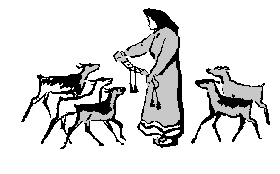Mäetagused vol. 6
Summary
The Mythology of Ob-Ugrians. III
Aado Lintrop
The third part of the research on the folk belief of the Ob-Ugrians.
Relative from Across the River of Blood: Lapp Folk Tales About Totem Reindeer. III
Enn Ernits
 There are two motifs in stories about taking a wife: wooing and the visit of the fater- and mother-in-law. The wooers are either animals or people in animal costumes. Unlike in the first subtype, the wooers are active. Animals obviously represent totems.
There are two motifs in stories about taking a wife: wooing and the visit of the fater- and mother-in-law. The wooers are either animals or people in animal costumes. Unlike in the first subtype, the wooers are active. Animals obviously represent totems.
One variant of a Turja fairytale has obvious infulences from the Indo-European wonder-fairytale "Frog the Princess" (AT 402) where the proposer is given difficult tasks and where the wife burns her husband's skin. In another variant, married girls leave their parents in zoomorphic form. In a couple of variants, the mother wants to wed her younger daughter to her totem animal.
The two variants of the third subtype represent a contamination of stories of a reindeer and dog marrying and its motifs are not clear. In both variants, future brides cross a taboo, for which they are turned into stone.
A God With Staves - A Problematic Figure
Tarmo Kulmar
The Mochika culture is one of the oldest and most problematic among Peru's pre-Columbus cultures. Its center was situated in the northern coast in the valley of the river Moche, not far from the current city Trujillo. The first monuments of the Mochika culture were discovered in 1900 by Max Uhle, one of the founders of Peru's national science of archaeology. Back then, as the oldest civilization of Peru – Chavin – had not been discovered yet, Uhle came forth with the so-called immigrational theory according to which Peru's civilizations, including Mochika have received their initial influence from Meso-America. After Julio Tello's discoveries in 1919, the autochthonic theory of the forthcoming of Peru's civilizations started to predominate. The god with staves appears for the first time in Peru in the Chavin era (900 BC - 200 AD). Its classical figure is known by the so-called Raimond's stele. It is a god depicted holding a staff or stick in both hands. Other exterior features may vary by cultures.
The History of Mars' Canals
Tõnu Tuvikene
The article presents a short history of the research of the so-called Mars Canals from their sighting in 1877 to the final decision of them being an illusion in the 1960s.
The Folklore Process
Lauri Honko
The theoretical article by L. Honko follows the changing of the notion "folklore". A thorough change have undergone attitude towards the informant, creator, needer and performer of traditions. Instead of people, there are social groups that can be defined by their social status, profession, ethnical background, religion, place of living and whatever other criteria and what makes it possible to speak about a circle of members. L. Honko treats the basic new definitions of folklore and divides the folklore process into 22 stages, the 12 first of which are part of folklore's "first life" or take place on the basis of those criteria being filled, the rest 10 stages are folklore's "second life«.
Political Anecdotes. V
Kadi Sarv
The majority of material used in this article originates from the Estonian Folklore Archives. In the fifth part of the article series is given an overview of political anecdotes popular in the period of Soviet occupation. A selection of anecdotes about Gorbachev and the last years of the Soviet Union are presented. The second half of the article is made up of articles depicting Estonian politicians and political situation. In the article is included a call on everybody to send in new anecdotes about politicians to the archive.

|
|
8 Mb .mp2 |
A New Song
Arranged by Aleksander Sünter on the themes of runo songs Shy Suitor and Cheater Groom. Comments by Aleksander Sünter and Vaike Sarv.
Pictures of Setomaa
Notes of a Traveler. August 19-23, 1996
Mariann Remmel
The first part of an expedition diary to Setumaa.
Some Old Lovely Stories for Young and Old for Christmas
Kristi Salve
A selection of Estonian tales about Christmas.

 There are two motifs in stories about taking a wife: wooing and the visit of the fater- and mother-in-law. The wooers are either animals or people in animal costumes. Unlike in the first subtype, the wooers are active. Animals obviously represent totems.
There are two motifs in stories about taking a wife: wooing and the visit of the fater- and mother-in-law. The wooers are either animals or people in animal costumes. Unlike in the first subtype, the wooers are active. Animals obviously represent totems. 
